“Autumn Day on the French Broad River”
In my art studio, I usually just quietly work on this or that oil painting. Some of the pieces have no story behind them at all. Some paintings are just based on an idea from my imagination, and some are based on a nice photo provided by a client seeking a commission. But if you were to visit my studio in Asheville’s River Arts District, some of the paintings you would see would have stories behind them and I’m taking this opportunity to share some of those stories.
This painting, entitled "Autumn Day on the French Broad River" is one that always puts a smile on my face. Joy and I love to tube down the French Broad River in the summer months. We park one car in the River Arts District and then bring our picnic (bagged watertight) in our second car and drive up the river about five miles, blow up the inner tubes and shove off. Talk about an utterly relaxing way to spend the afternoon. When I say "relaxing" I mean truly bordering on boring, as the river usually seems to be flowing at about a mile an hour. I love it.
By the time I painted it, “summer” themed scenes would be harder to sell, so I “autumn-ized” it.
So, we were floating down the river and there was this really cool tree overhanging the water and I knew I needed a photo of it. But by the time I realized that fact, I was almost past it. Thinking very quickly, I grabbed one of the lowest branches and stopped our ponderous progress down the river. After wading out into the water, I got us to shore, then walked back up the river (with my iPhone camera safely ensconced in it's ziplock bag) and put in the river again. This time I was ready, and I got my shot. I was happy. Joy was rolling her eyes.
I loved the composition but the only problem was that it was nearing mid-summer. By the time I painted it, "summer" themed scenes would be harder to sell, so I "autumn-ized" it. Easy. Rather than the greens, I applied golds, yellows and deep siena browns. The result was a piece I was really happy with. And it takes me back to that pleasant day in the river with my wife Joy. :)













